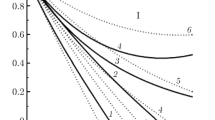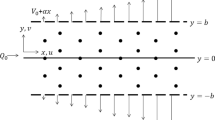Summary
The electrical resistance of collecting duct epithelium of the hamster kidney was measured in situ during luminal perfusion of the duct lumen with 0.3 molar NaCl solution. Three different approaches were used: 1. Determination of the voltage attenuation along an unbranched duct segment of the open collecting duct system. 2. Determination of the input resistance of the entire collecting duct tree and 3. determination of the input resistance of short unbranched duct segments, which were terminated at their upper and lower ends with insulating resin. Using models of bifurcating cable systems, described in the appendix, the specific membrane resistanceR m was calculated from experiment 1 and 2 to be 2 kΩ cm2, while experiment 3, after correction for leaks, yielded a value of approximately 1 kΩ cm2. The data confirm that collecting duct transepithelial resistance is one or two orders of magnitude higher than the resistance of distal and proximal tubule, respectively.
Similar content being viewed by others
References
Baldamus, C. A., Hierholzer, K., Rumrich, G., Stolte, H., Uhlich, E., Ullrich, K. J., Wiederholt, M.: Natriumtransport in den proximalen Tubuli und in den Sammelrohren bei Variation der Natriumkonzentration im umgebenden Medium. Pflügers Arch.310, 354–368 (1969)
Berkinblit, M. B., Kovalev, S. A., Smolyaninov, V. V., Chailakhyan, L. M.: Input resistance of syncytial structures. Biophysics10, 341–351 (1965)
Coraboeuf, E.: Resistance measurements by means of microelectrodes in cardiac tissues. In: Glass microelectrodes. M. Lavallée, O. F. Schanne, and N. C. Hébert, eds., pp. 224–271. New York-London: Wiley 1969
Fatt, P., Katz, B.: The electrical properties of Crustacean muscle fibers. J. Physiol. (Lond.)120, 171–204 (1953)
Feldtkeller, R.: Einführung in die Vierpoltheorie der elektrischen Nachrichtentechnik. Stuttgart: Hirzel 1953
Frömter, E., Diamond, J. M.: Route of passive ion permeation in epithelia. Nature New Biol.235, 9–13 (1972)
Frömter, E., Rumrich, G., Ullrich, K. J.: Phenomenologic description of Na+, Cl− and HCO3 − absorption from proximal tubules of the rat kidney. Pflügers Arch.343, 189–220 (1973)
George, E. P.: Resistance values in a syncytium. Aust. J. exp. Biol. med. Sci.39, 267–274 (1961)
Gruber, W. D., Knauf, H., Frömter, E.: The action of aldosterone on Na+ and K+-transport in the rat submaxillary main duct. Pflügers Arch.344, 33–49 (1973)
Hegel, U., Frömter, E., Wick, T.: Der elektrische Wandwiderstand des proximalen Konvolutes der Rattenniere. Pflügers Arch. ges. Physiol.294, 274–290 (1967)
Helman, S. I., Grantham, J. J., Burg, M. B.: Effect of vasopressin on electrical resistance of renal cortical collecting tubules. Amer. J. Physiol.220, 1825–1832 (1971)
Johnson, E. A., Sommer, J. R.: A strand of cardiac muscle. Its ultrastructure and the electrophysiological implications of its geometry. J. Cell Biol.33, 103–129 (1967)
Loewenstein, W. R., Kanno, Y.: Studies on an epithelial (gland) cell junction. I. Modifications of surface membrane permeability. J. Cell Biol.22, 565–586 (1964)
Malnic, G., Giebisch, G.: Some electrical properties of distal tubular epithelium in the rat. Amer. J. Physiol.223, 797–808 (1972)
Rau, W. S., Frömter, E.: Electrical properties of the medullary collecting ducts of the golden hamster kidney. I. The transepithelial potential difference. Pflügers Alch.351, 99–111 (1974)
Steinhausen, M.: In vivo-Beobachtungen an der Nierenpapille von Goldhamstern nach intravenöser Lissamingrün-Injektion. Pflügers Arch. ges. Physiol.279, 195–213 (1964)
Taylor, R. E.: Cable theory. In: Physical techniques in biological research, W. L. Nastuk, Ed. New York: Academic Press 1963
Timmermans, J.: The physico-chemical constants of binary systems in concentrated solutions, Vol. 3, p. 335. New York: Interscience Publ. 1960
Uhlich, E., Halbach, R., Ullrich, K. J.: Einfluß von Aldosteron auf den Ausstrom markierten Natriums aus den Sammelrohren der Ratte. Pflügers Arch.320, 261–264 (1970)
Ussing, H. H.: The alkali metal ions in isolated systems and tissues. In: Handbuch der experimentellen Pharmakologie, O. Eichler u. E. Farah, Hrsg., pp. 1–195. Berlin-Heidelberg-New York: Springer 1960
Walser, M.: Role of edge damage in sodium permeability of toad bladder and a means of avoiding it. Amer. J. Physiol.219, 252–255 (1970)
Weber, H.: Über die stationären Strömungen der Electricität in Cylindern. Borchardts J. Math.76, 1–20 (1873)
Author information
Authors and Affiliations
Rights and permissions
About this article
Cite this article
Rau, W.S., Frömter, E. Electrical properties of the medullary collecting ducts of the golden hamster kidney. Pflugers Arch. 351, 113–131 (1974). https://doi.org/10.1007/BF00587431
Received:
Issue Date:
DOI: https://doi.org/10.1007/BF00587431




